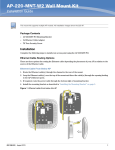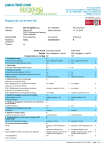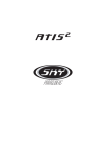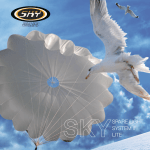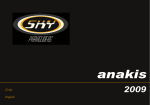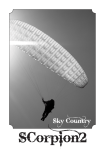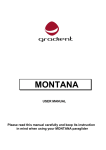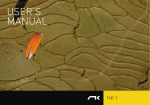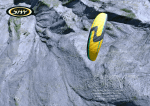Download File - SKY Paragliders
Transcript
Rescue Parachute User Manual Sky Paragliders, a.s. Kadlčákova 1466 739 11 Frýdlant nad Ostravicí CONTENT CHAPTER I. Technical Specification of Rescue Parachute SKY DRIVE 1) 2) 3) 4) 5) 6) 7) 8) 9) 10) 11) 12) Intended Use Technical-Tactical Parameters Design Warranty Parachute Durability Operating Conditions Storage time Parachute Installation Parachute Function Parachute Assembly Technical Specification of Individual Parachute Parts Materials CHAPTER II. Instructions for Parachute Use 1) Preparing the parachute prior to takeoff 2) Opening the parachute CHAPTER Ill. Parachute Storage Instructions 1) Storage conditions CHAPTER IV. Parachute Packing Instructions CHAPTER I. Technical Specification of Rescue Parachute SKY DRIVE 1 ) Intended Use: Rescue parachute SKY DRIVE is intended for paragliding, for installation into paragliding harnesses. 2) Technical-Tactical Parameters: - canopy area weight min. a max. pilot weight maximum speed upon opening parachute maximum descending speed at 110 kg load maximum forward speed at 110 kg load 26 m2 2,4 kg 70- 110 kg 115 km/h 5,3 m/s 5,4 m/s 3) Design: The parachute is produced in a standard design. The following options are available upon request: - various colours available 4) Warranty: The warranty period is 6 months and is valid from the date of dispatch. The manufacture shall not honour claims in the following cases: if the user breaches conditions for parachute packing, storage and treatment - if the parachute is damaged when used otherwise than intended and designed - if the parachute is damaged by catching on other equipment, tree or other fixed object 5) Parachute Durability: If any damage or wear of parachute material is found, contact the manufacture or your dealer immediately. The parachute owner is obliged to inspect and check the condition of the parachute after every use, and after 10 uses the parachute must be returned to the manufacturer or authorised person for thorough inspection. 6) Operating Conditions: The parachute functions are guaranteed in an air temperature range from -40°C to +80°C and relative humidity corresponding to this temperature range. The parachute is designed for a maximum speed of 115 km/h. 7) Storage time: The parachute may be packed for a maximum period of 1 year prior to use. 8) Parachute Installation The parachute is designed for use in paragliding harnesses as a rescue parachute. The parachute is attached to the harness by means of threaded buckles (type Maillon) with a minimum declared strength of 4500 N. The right strap, which is marked R (right), is attached to the right eye for the rescue parachute, control handles to the rear, on the harness; the left is attached analogously. The placement of the rescue parachute into the rescue parachute casing is subject to technical specification of the used harness. The parachute can be used for all standard locations (in front, under the harness, on the side). Only qualified persons or the manufacturer may install the rescue parachute into the harness. 9) Parachute Function: The rescue parachute is used as a safety measure for paragliders. The parachute is activated by pulling out the release, which is fixed to the container where the rescue parachute is located, and throwing this container to the side. The container must be thrown in such a manner as to avoid it getting tangled in the paraglider. After the container is thrown aside it opens, the cords extend, and the rescue parachute canopy is released and filled with air. Provided the pilot has sufficient height and weather conditions are suitable, the control handles can be used to adjust the descend trajectory to avoid obstacles or to land in a suitable area. 10) Parachute Assembly: The parachute has the following main parts: I. II. III. IV. V. Container Canopy with cords Threaded buckles H-shaped support straps Control handles 11) Technical Specification of Individual Parachute Parts: 11.1. Container: The container accommodates the folded canopy and cords. The trigger is attached to the container. The trigger can be connected to the centre or side of the container. The container has two side flaps and one top flap. The container is closed by a loop of cords inserted into a closing rubber eye. 11.2. Canopy with cords: The canopy with an area of 26 m2 is made of polyamide with a permeability of 0-3 l. The canopy is delta shaped and has 22 support cords attached in four rows. Forces from the cord eyes are distributed into the canopy through straps (13 and 25 mm thick). Other stressed canopy sections are reinforced by 13mm thick straps. 11.3. Threaded buckles: Threaded buckles are located at the ends of cords and are used to connect cords with support straps. Maillon buckles with a guaranteed strength of min. 4500 N are used. 11.4. Support straps: These H-shaped straps are used to connect the rescue parachute to the harness. The right strap is marked with the letter R (right). 11.5. Control handles: These are used to control and parachute. The control cords are terminated at the control handles. 12) Materials: Material type: Manufacture: Use: polyamide fabric 9024 polyamide strap 13 mm polyamide strap 25 mm polyamide strap 15 mm polyamide cord D=4mm polyamide strap 25 mm threaded buckles Mailon 4500N polypropylene fabric Porcher marine Stap Stap Stap Lanex Bolatice A. Mouka Peguet Technolen canopy canopy reinforcement canopy reinforcement canopy reinforcement, cord eyes support cords connecting straps strap-cord connection container material CHAPTER II. Instructions for Parachute Use 1 ) Preparing the parachute prior to takeoff: Prior to takeoff the parachute and release system must be checked. If any defects are found, takeoff must be aborted. 2) Opening the Parachute: The rescue parachute is used when the paraglider is defective or damaged to such an extent that it doesn’t allow for safe landing. The parachute is activated by pulling out the release, which is fixed to the container where the rescue parachute is located, and throwing this container to the side. The container must be thrown in such a manner as to avoid it getting tangled in the paraglider. After the container is thrown aside it opens, the cords extend, and the rescue parachute canopy is released and filled with air. At this moment the rescue parachute is fully functional. The non-functional paraglider must be suitably collapsed or otherwise disposed of, so that it doesn’t affect the reliable function of the rescue parachute. If the connection between the paraglider and harness allows for quick release, this function should be used to dispose of the paraglider and land using only the rescue parachute. One must remember that the rescue parachute has quite a high forward speed and an inappropriate procedure during its opening and handling with a defective paraglider could lead to both becoming entangled and collapsing. 3) Controlling the Parachute: The parachute is controlled using control handles located on the support straps. The rescue parachute parameters enable sufficient manoeuvring capability for emergency landing. Control is done in a typical manner, i.e. pulling on the right control handle turns the parachute to the right, pulling on the left control handle turns the parachute to the left. Pulling on both control handles simultaneously slows the parachute speed and descending down only slightly, which means that the increase in lift upon landing as with a paraglider. Avoid unnecessary interference with steering, alternative pulling on both control handles, etc. could cause the parachute to swing which is dangerous during landing. When flying and landing with a collapsed paraglider we recommend controlling the rescue parachute with one hand. The other hand should continuously keep check of the collapsed paraglider to avoid unwanted inflation and potential entangling with the rescue parachute. If conditions allow, always land with the rescue parachute into the wind. We recommend turning into the wind towards the selected landing area and not intervening in steering below a height of 40 m. CHAPTER Ill. Parachute Storage Instructions 1) Storage Conditions: Parachutes are stored in a dry, dark and well ventilated area. If the parachute is stored for longer than one year, it must be stored unpacked. Parachutes shall under no circumstances be stored together with acids, oils, diluents or other aggressive substances. RESCUE PARACHUTE PACKING INSTRUCTIONS SKY DRIVE 1) Checking the canopy: Prior to actual packing the parachute must be thoroughly checked and in case any defects are found the parachute must not be packed for use. Take care that the cords are tensed throughout the packing procedure. 2) Checking cords: Lay the canopy on the packing table with the front section facing up and separate the cords from one another. The canopy and cords should now be arranged. If the cords are tangled, they must be untangled and straightened out. In case of doubt consult an authorised packer. Check the right procedure by rechecking the cords. Divide the cords into a right and left half according to the loose ends, the border between the left and right section in the canopy is a 2,5 cm thick strap with central cords. With the parachute arranged in this manner, lay it on the packing table with the trailing edge towards the ground and tip pointing upwards. Check that cords pass freely from the loose ends to the canopy in the following order: F, F1, E, E1, D, D1, C, C1, B, B1, A. The first cord from the centre of the parachute at the loose ends leads to the canopy tip and the last cord at the loose ends leads to the centre of the trailing edge. Fig. 1 3) Arrange the centre of the parachute so that both centre rows of cords lie on top of each other and fold the right canopy side (in direction of flight) to the left side. Align the parachute centre so that both centre cord rows, in order F, E, D, C, B, A lie on top of each other, fold the right canopy side (in direction of flight) to the left side. Fold the canopy from the trailing edge towards the tip, left and right side separately. Take care that cords are tensed at all time during packing. Fig. 2 4) Fold the first part in an S-shape into thirds into a triangle and then fold the entire section in half towards the centre of the parachute according to Fig. 3. The centre cord marked F is used as the first and basic cord for packing, to which the following cords are added in the given order. The first added cord is marked F1 (control cord) is placed next to centre cords. The shape of the first field in the bottom section is demarcated by a strap between strap F1 and F; in the top section it is a piece of fabric between the centre strap and point “X”. Point X is determined by extending the axis of cord F1 through to the point of crossing reinforcement straps. The bottom strap of the first field is folded towards the centre so that it is parallel to the cords axis. Now repeat the entire operation (the result is a folded field in the shape of a triangle). Take care that the cords are tensed at all times. Fig. 3 Fig. 4 Fig. 5 Arrange the other sections so that the strap from the support cord lies immediately next to and parallel to the arranged parachute centre. The bottom edge of the section is folded towards the parachute centre (Fig. 2) and then folded according to the bottom section (Fig. 3). Then lay the next cord E1 onto F1 towards the centre of the parachute. In the cord axis continues a strap into the parachute, this is laid down onto the centre strap. Fold the bottom strap of this second field towards the parachute centre parallel to the centre cords. (the result is a field folded in a triangular shape). Take care that the cords are tensed at all times. Fig. 6 Fig. 7 Fig. 8 5) Layout the next section, fold the bottom edge of the section towards the parachute centre and then fold it in half towards the parachute centre. Place the next cord D1 onto E1 towards the parachute centre. In the cord axis continues a strap into the parachute, this is laid down onto the centre strap. Fold this field lengthwise in half towards the parachute centre. (the result is a field folded in a rectangular shape). Take care that the cords are tensed at all times. Fig. 9 Fig. 10 Fig. 11 6) Fold the next section in exactly the same way. Place the next cord C1 onto D1 towards the parachute centre. In the cord axis continues a strap into the parachute, this is laid down onto the centre strap. Fold this field lengthwise in half towards the parachute centre. (the result is a field folded in a rectangular shape). Take care that the cords are tensed at all times. Fig. 12 Fig. 13 Fig. 14 7) Again, folding of the next section is exactly the same. Make the folds so that individual support cord rows are next to each other and cords are tensed. Place the next cord B1 onto C1 towards the parachute centre. In the cord axis continues a strap into the parachute, this is laid down onto the centre strap. Fold this field lengthwise in half towards the parachute centre. (The result is a field folded in a rectangular shape). Take care that the cords are tensed at all times. Fig. 15 Fig. 16 Fig. 17 8) Layout the last section and fold it towards the parachute centre into a triangular shape The last centre tag marked “A” remains on the centre parachute axis. Fold the bottom strap of this last field towards the parachute centre parallel to the centre cords. (the result is a field folded in a triangular shape). Fig. 18 Fig. 19 9) Weigh down the folded half of the parachute with weights; fold the remaining half (unfolded) over this first half and fold it in exactly the same way. Fig. 20 Fig. 21 Fig. 22 10) Fold the parachute into thirds After gathering the left and right halves of the canopy check that individual cords pass freely from the canopy to the loose ends. After checking the canopy cords, separate them lengthwise into thirds and place the side bundles onto the centre one. Fig. 23 Fig. 24 Fold the parachute in an S shape so that its size in the folded state corresponds to the size of the container. Now fold the canopy transversely into a pyramid whose base shall have the size of the container. Fig. 25 Fig. 26 Fig. 27 Fig. 28 11) Place the parachute into the container; fold the cords in an S shape, secure with rubber rings. Close the container by passing the rubber eye through a steel ring of the opposite side flap and then through the ring of the top flap. Finally, close the container by a loop made of cords inserted into the rubber eye. Caution! Do not pass the strap with cords through the closing rubber. 12) Test the opening of the container by grabbing the straps of the rescue parachute and attempting to lift the parachute. If the last loop of cords became loose and the container opened, your packing was correct; if not then you made a mistake somewhere (see Caution in Article 11.). 13) Close the container again according to Article 11. Important: If during packing you used “weights” or other objects to hold down the already folded section of the parachute, check that you have the same number after finishing packing. Weights or any other objects must not be packed into the rescue parachute! 14) Place the container with rescue parachute into the harness as per technical specification of the harness used. The parachute can be used in all standard locations (front, rear, sides). Installation of the rescue parachute into the harness must be done by a duly qualified and authorised person or the manufacturer. Packing the rescue parachute in the container into the casing. • Connect the trigger to the container by passing the loop on the trigger through the eye on the container and then pass the handle through the loop – you will get a knot between the trigger and eye on the container. • Fold the straps of the rescue parachute in an S shape at the bottom of the casing • Place the rescue parachute with attached trigger so that the trigger is on top • After closing the casing of the rescue parachute you will need a piece of rope about 40cm long. Thread the rope through the rope eye sewn onto flap “A” • Gradually (A-F) thread the rope through steel eyes so that you pull a cord eye from the last steel eye and secure it with a steel pin • Pull the rope from the cord eye, best under the pin • Fix the handle by velcro straps to flap A and B • Push the corners of the rescue parachute casing under the flap























